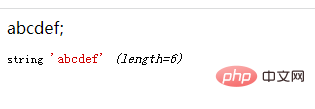How to remove the last semicolon in php
3 ways to remove the last semicolon in php: 1. Use the rtrim() function to remove it. You can delete the specified characters at the end of the string. The syntax is "rtrim($str, ";")"; 2. Use the substr() function to remove, you can trim the last character in reverse order, the syntax is "substr($str,0,-1)"; 3. Use the mb_substr() function to remove, you can trim the last character in reverse order, the syntax is " mb_substr($str,0,-1,"Character encoding")".

The operating environment of this tutorial: windows7 system, PHP8 version, DELL G3 computer
Remove the last one from the php string Semicolon method
Method 1: Use the rtrim() function to remove the last semicolon
The rtrim() function can delete the end of the string White space characters (or other characters)
rtrim($str, "指定字符")
Example:
<?php header('content-type:text/html;charset=utf-8'); $num = "1;2;3;4;5;6;"; $str = rtrim($num, ";") ; echo $num; var_dump($str); ?>

Note: The rtrim() function will delete consecutive characters on the right.
If the last few characters are consecutive, they will be deleted together
<?php header('content-type:text/html;charset=utf-8'); $str = "php中文网;;;;"; echo $str; $str = rtrim($str,";"); var_dump($str); ?>

Method 2: Use the substr() function to remove the last semicolon
Use the substr() function to cut off the last character in reverse order (this function cannot be used for Chinese characters).
substr(string,start,length)
| Parameters | Description |
|---|---|
| string | Required . Specifies a part of the string to be returned. |
| start | Required. Specifies where in the string to begin.
|
| length | Optional. Specifies the length of the string to be returned. The default is until the end of the string.
|
Return value: The extracted part of the string, FALSE if failed, or an empty string.
If you want to use the substr() function to remove the last semicolon, use the following statement:
substr($str, 0, -1)
Example:
<?php $str1 = "abcdef;"; echo $str1; $str1 = substr($str1, 0, -1); var_dump($str1); $str2 = "abcdef;;"; echo $str2; $str2 = substr($str2, 0, -1); var_dump($str2); ?>

Explanation: The mb_substr() function is different from the rtrim() function. It will not delete consecutive characters, but will only delete the specified number of characters at the specified position.
Method 3: Use the mb_substr() function to remove the last semicolon
The usage of the mb_substr() function is the same as the substr() function, cutting off the last digit in reverse order Characters are enough; but this function can be used for Chinese characters.
mb_substr($str,$start,$length,$encoding)
| Parameters | Description |
|---|---|
| str | Required . Extracts a substring from this string. |
| start | Required. Specifies where in the string to begin.
|
| length | Optional. Specifies the length of the string to be returned. The default is until the end of the string.
|
| encoding | Optional. Character Encoding. If omitted, the internal character encoding is used. |
#Return value: Returns the extracted part of the string, returns FALSE if it fails, or returns an empty string.
Example:
<?php $str = "abcdef;"; echo $str; $str = mb_substr($str, 0, -1,"utf-8"); var_dump($str); ?>

Recommended study: "PHP Video Tutorial"
The above is the detailed content of How to remove the last semicolon in php. For more information, please follow other related articles on the PHP Chinese website!

Hot AI Tools

Undresser.AI Undress
AI-powered app for creating realistic nude photos

AI Clothes Remover
Online AI tool for removing clothes from photos.

Undress AI Tool
Undress images for free

Clothoff.io
AI clothes remover

Video Face Swap
Swap faces in any video effortlessly with our completely free AI face swap tool!

Hot Article

Hot Tools

Notepad++7.3.1
Easy-to-use and free code editor

SublimeText3 Chinese version
Chinese version, very easy to use

Zend Studio 13.0.1
Powerful PHP integrated development environment

Dreamweaver CS6
Visual web development tools

SublimeText3 Mac version
God-level code editing software (SublimeText3)

Hot Topics
 1667
1667
 14
14
 1426
1426
 52
52
 1328
1328
 25
25
 1273
1273
 29
29
 1255
1255
 24
24
 PHP: A Key Language for Web Development
Apr 13, 2025 am 12:08 AM
PHP: A Key Language for Web Development
Apr 13, 2025 am 12:08 AM
PHP is a scripting language widely used on the server side, especially suitable for web development. 1.PHP can embed HTML, process HTTP requests and responses, and supports a variety of databases. 2.PHP is used to generate dynamic web content, process form data, access databases, etc., with strong community support and open source resources. 3. PHP is an interpreted language, and the execution process includes lexical analysis, grammatical analysis, compilation and execution. 4.PHP can be combined with MySQL for advanced applications such as user registration systems. 5. When debugging PHP, you can use functions such as error_reporting() and var_dump(). 6. Optimize PHP code to use caching mechanisms, optimize database queries and use built-in functions. 7
 PHP and Python: Comparing Two Popular Programming Languages
Apr 14, 2025 am 12:13 AM
PHP and Python: Comparing Two Popular Programming Languages
Apr 14, 2025 am 12:13 AM
PHP and Python each have their own advantages, and choose according to project requirements. 1.PHP is suitable for web development, especially for rapid development and maintenance of websites. 2. Python is suitable for data science, machine learning and artificial intelligence, with concise syntax and suitable for beginners.
 PHP vs. Python: Understanding the Differences
Apr 11, 2025 am 12:15 AM
PHP vs. Python: Understanding the Differences
Apr 11, 2025 am 12:15 AM
PHP and Python each have their own advantages, and the choice should be based on project requirements. 1.PHP is suitable for web development, with simple syntax and high execution efficiency. 2. Python is suitable for data science and machine learning, with concise syntax and rich libraries.
 PHP in Action: Real-World Examples and Applications
Apr 14, 2025 am 12:19 AM
PHP in Action: Real-World Examples and Applications
Apr 14, 2025 am 12:19 AM
PHP is widely used in e-commerce, content management systems and API development. 1) E-commerce: used for shopping cart function and payment processing. 2) Content management system: used for dynamic content generation and user management. 3) API development: used for RESTful API development and API security. Through performance optimization and best practices, the efficiency and maintainability of PHP applications are improved.
 The Enduring Relevance of PHP: Is It Still Alive?
Apr 14, 2025 am 12:12 AM
The Enduring Relevance of PHP: Is It Still Alive?
Apr 14, 2025 am 12:12 AM
PHP is still dynamic and still occupies an important position in the field of modern programming. 1) PHP's simplicity and powerful community support make it widely used in web development; 2) Its flexibility and stability make it outstanding in handling web forms, database operations and file processing; 3) PHP is constantly evolving and optimizing, suitable for beginners and experienced developers.
 PHP and Python: Different Paradigms Explained
Apr 18, 2025 am 12:26 AM
PHP and Python: Different Paradigms Explained
Apr 18, 2025 am 12:26 AM
PHP is mainly procedural programming, but also supports object-oriented programming (OOP); Python supports a variety of paradigms, including OOP, functional and procedural programming. PHP is suitable for web development, and Python is suitable for a variety of applications such as data analysis and machine learning.
 PHP vs. Other Languages: A Comparison
Apr 13, 2025 am 12:19 AM
PHP vs. Other Languages: A Comparison
Apr 13, 2025 am 12:19 AM
PHP is suitable for web development, especially in rapid development and processing dynamic content, but is not good at data science and enterprise-level applications. Compared with Python, PHP has more advantages in web development, but is not as good as Python in the field of data science; compared with Java, PHP performs worse in enterprise-level applications, but is more flexible in web development; compared with JavaScript, PHP is more concise in back-end development, but is not as good as JavaScript in front-end development.
 PHP and Python: Code Examples and Comparison
Apr 15, 2025 am 12:07 AM
PHP and Python: Code Examples and Comparison
Apr 15, 2025 am 12:07 AM
PHP and Python have their own advantages and disadvantages, and the choice depends on project needs and personal preferences. 1.PHP is suitable for rapid development and maintenance of large-scale web applications. 2. Python dominates the field of data science and machine learning.




